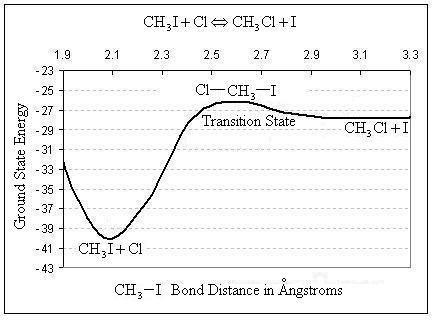Introduction
What will we be using in this web module?
1. Quantum Mechanics
2. Statistical Mechanics
3. Transition State Theory
What is quantum mechanics?
"During the latter part of the 19th century, physicists were justly
proud of the apparent completeness of their subject. Newton's laws and the
electromagnetic wave theory of Maxwell had successfully explained most of
the phenomena they were interested in. As experiments were able to go to lower
temperatures and to both shorter and longer wavelengths of radiation, problems
arose which showed that the classical laws [of the motion of matter] did not
explain phenomena on the atomic or molecular level."[1] In a effort to
explain these decrepencies quantum mechanics was born.
Quantum mechanics mathematically describes the motion of electrons via a
simple postulate. The postulate states that energy can only be transferred
from the particle's surroundings to a particle in specific quantities. It
turns out that many useful properties of atoms and molecules can be predicted
using quantum mechanical calculations. For example, heats of reaction, rate
constants, molecular vibrational frequencies, and many other physical properties
can be calculated using quantum mechanical methods, without any prior knowledge
from experiments. Just as this intrinsic reaction coordinate was calculated
using the Spartan program:

A brief background on quantum mechanical calculations is provided here, click
here for the background. Fortunately, computational chemistry software
has advanced to the point that we can perform calculations based on quantum
chemistry without having to work through all the details ourselves. We will
explore the use of some of this software in the present exercise.
What is statistical mechanics?
Statistical mechanics is defined as the study of the properties of a macroscopic
system as predicted by the statistical behavior of its constituent microscopic
particles. Statistical mechanics was developed by many different historical
scientists over the last century. Statistical mechanics is used to calculate
thermodynamic quantities from microscopic properties of a system. Because
of its wide reaching applications we will only focus on what we will be using
within this web module. First we will discuss some of the key aspects of statistical
mechanics that will be applied in this web module. First, partition functions
are mathematical functions that take into account the many ways that energy
can be partitioned (i.e, distributed) in a system. The four partition functions
that we (the programs) will be dealing with are vibrational, translational,
rotational, and electronic partition functions. These four partition functions
describe the four different ways that a quantity, such as energy, can be distributed
within a microscopic system. With these partition functions, one can calculate
the enthalpy, entropy, heat capacity, and zero point energy. For a more in-depth
discussion of statistical mechanics select one of the
document types
(HTML,
PDF).
What is transition state theory?
Transition state theory basically states that in a chemical reaction the
reactants proceed through a high energy transition state before forming the
products of the reaction. Basically, several quantities such as the activation
energy and the preexponential factor can be calculated using thermodynamic
mathematical relationships and the thermodynamic quantities of the transition
state. Transition state theory relies upon many mathematical and theoretical
foundations fet forth by statistical mechanics and quantum mechanics. For
a in-depth background on transition state theory and an example of how quantum
mechanics, statistical mechanics, and transition state theory are coupled select one of the
document types
(HTML,
PDF).
What are the applications to chemical engineering?
Quantum mechanics, statistical mechanics, and transition state theory can
be applied to many chemical engineering problems, and are used for applications
ranging from the manufacture of large-volume petrochemicals to characterization
of enzyme-substrate interactions to analysis of thin film deposition on semiconductor
chips. For chemical engineers, molecular modeling calculations are most useful
in determining kinetic and thermodynamic properties of a reaction system.
The next generation of chemical engineers will rely heavily on molecular modeling
and quantum mechanical calculations to design reactions to produce pharmaceuticals,
industrial chemicals, and complex molecules. Here's a list of what we'll be
using these sorts of calculations to do:
Quantities that can be calculated using Quantum
Mechanical Software
- Enthalpy of each state
- Gibbs free energy for each state
- Entropy for each state
- Heat of reaction
- Activation energy
- Preexponential factor
- Rate constant as a function of temperature
- Total bond energy, heat of formation, or total energy of the molecule
Now we will further introduce the applications to chemical engineering
with an example.


